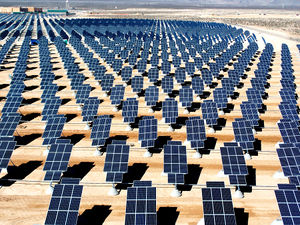Photovoltaic electricity: Difference between revisions
J.williams (talk | contribs) No edit summary |
J.williams (talk | contribs) m (1 revision imported) |
(No difference)
| |
Revision as of 21:31, 26 August 2015

Photovoltaic electricity is the electricity generated by the conversion of radiant energy, most commonly done by photovoltaic cells. It uses the principles of Einstein's photoelectric effect, which he received a Nobel Prize for.[2] Photovoltaic electricity is the energy currency obtained from solar energy, where incoming light from the Sun can be harnessed for use by humans. Solar panels containing many photovoltaic cells generate this electricity.
The electricity is generated by the flow of electrons in a semiconductor, which are knocked out of their atomic orbit by incoming photons. Photovoltaic electricity is becoming more popular as the technology becomes cheaper and the push for renewable energy becomes more prominent. Reducing greenhouse gas emissions is a goal that many are striving to achieve, and photovoltaic cells are a part of this effort.[3]
For more information, please visit the page on semiconductors and photovoltaic cells.
For further reading, NASA explains how to generate photovoltaic electricity, and read about Canada's efforts to accelerate the use of this energy.
References
- ↑ Wikimedia Commons, Available: http://upload.wikimedia.org/wikipedia/commons/4/45/Giant_photovoltaic_array.jpg
- ↑ NobelPrize.org, The Nobel Prize in Physics 1921 [Online], Available: http://www.nobelprize.org/nobel_prizes/physics/laureates/1921/
- ↑ NRCan, Solar Photovoltaic Energy [Online], Available: https://www.nrcan.gc.ca/energy/renewables/solar-photovoltaic/7303

